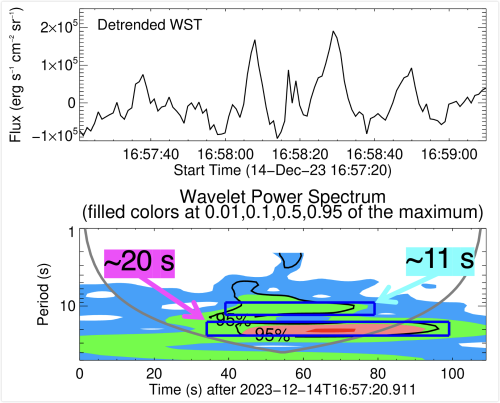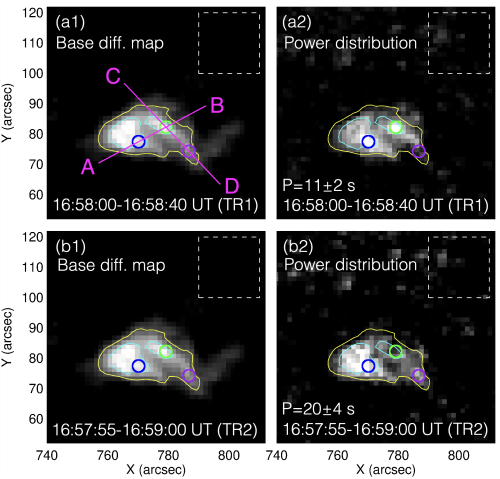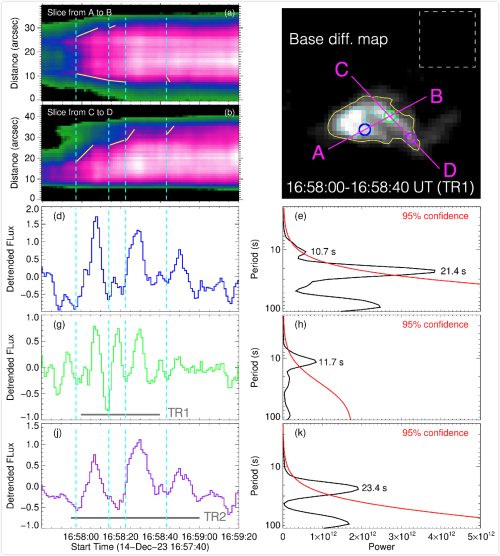Quasiperiodic Pulsations in the Balmer Continuum in an X-class Solar White-light Flare
| Nugget | |
|---|---|
| Number: | 499 |
| 1st Author: | De-Chao SONG |
| 2nd Author: | et al. |
| Published: | June 30, 2025 |
| Next Nugget: | TBD |
| Previous Nugget: | High-Resolution Observations of a C3 class White-Light Flare |
Introduction
Over 160 years ago, around 11:18 AM GMT on September 1, 1859, Richard Carrington and Richard Hodgson independently reported the first solar white-light flare (WLF), which was also the first solar flare that had been reported.
It is widely recognized that electromagnetic radiation enhancements during most solar flares predominantly occur in invisible bands, such as X-ray and ultraviolet, with only marginal enhancements in the white-light continuum. Compared to these "ordinary" flares, WLFs are particularly special due to their wider solar impact (potentially reaching down to the bottom of the photosphere), smaller enhanced emission areas, higher radiation power per unit area, and shorter durations. Thus, WLFs provide valuable examples for improving flare models. Our research (Ref. [1]) describes interesting pulsations seen, for the first time, in the energetically significant Balmer continuum. We think of this as something like the heartbeat of the flare, owing to its implied power.
Observations
On December 14, 2023, a powerful X2.8 class double-ribbon WLF (SOL2023-12-14T17:02) erupted. This event was observed with high cadence (1-2 s) in the Balmer continuum at 3600 Å by the White-light Solar Telescope (WST) onboard the ASO-S. The flare was simultaneously observed by multiple other instruments, such as the satellites SDO, SolO, Fermi, GOES, PROBA2, plus the ground-based EOVSA.
Results
For the first time, quasi-periodic pulsations (QPPs) with a fundamental period of approximately 20 s and a harmonic period of around 11 s were clearly detected in the Balmer continuum (see Figure 1) during the impulsive phase of the flare. This rare "heartbeat" QPP signature was corroborated by other instruments observing across different wavelengths.

Further Fourier analysis indicated stronger harmonic QPP power from the eastern flare ribbon, notably contributing to both the fundamental (20 s) and harmonic (11 s) periods (e.g., the region within the blue circle in Figure 2). Interestingly, some regions on the western flare ribbon exhibited significant power at the 11 s period but minimal contribution at 20 s (e.g., the region within the green circle in Figure 2). Meanwhile, some other regions showed the opposite pattern (e.g., the region within the purple circle in Figure 2).

According to multi-instrument observations, magnetic field extrapolations, and MHD theory, we suggest that kink-mode oscillations in flare loops may modulate the harmonic QPP generation. Combined with spatial distribution of the harmonic QPP sources (Figure 2), we propose that harmonic MHD oscillations (likely in the kink mode) in the majority of loops, and fundamental oscillations in a minority of loops may coexist.
Moreover, high-cadence imaging from WST revealed that the appearance of harmonic QPPs was highly synchronous with rapid flare ribbon elongation and separation motions (see Figure 3), suggesting that these "heartbeat" QPP signals are closely related to the basic energy conversion producing the flare.

Conclusions
Utilizing multi-band, high-cadence observations, this study investigates the emission properties of an X2.8 WLF, uncovering for the first time harmonic QPPs in the Balmer continuum at 3600 Å. This component of the emission spectrum of the flare contains a substantial fraction of the radiated energy, leading us to think of these oscillations as the heartbeat phenomenon. Future research will further investigate the underlying physical mechanisms using additional events and high-resolution observations.
Acknowledgements
The co-authors of the work described here and in Ref. [1] are Marie DOMINIQUE, Ivan ZIMOVETS, Qiao LI, Ying LI, Yang SU, B.A. NIZAMOV, Ya WANG, Andrea Fracesco BATTAGLIA, Jun TIAN, Li, FENG, Hui LI, and W.Q. GAN